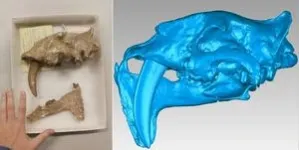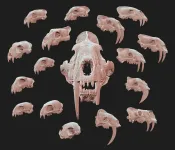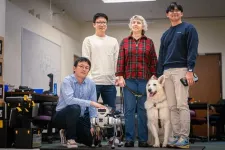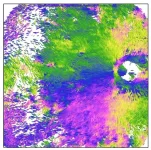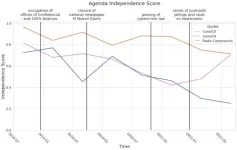(Press-News.org) 31 pyramids in Egypt, including the Giza pyramid complex, may originally have been built along a 64-km-long branch of the river Nile which has long since been buried beneath farmland and desert. The findings, reported in a paper in Communications Earth & Environment, could explain why these pyramids are concentrated in what is now a narrow, inhospitable desert strip.
The Egyptian pyramid fields between Giza and Lisht, built over a nearly 1,000-year period starting approximately 4,700 years ago, now sit on the edge of the inhospitable Western Desert, part of the Sahara. Sedimentary evidence suggests that the Nile used to have a much higher discharge, with the river splitting into several branches in places. Researchers have previously speculated that one of these branches may have flown by the pyramid fields, but this has not been confirmed.
Eman Ghoneim and colleagues studied satellite imagery to find the possible location of a former river branch running along the foothills of the Western Desert Plateau, very near to the pyramid fields. They then used geophysical surveys and sediment cores to confirm the presence of river sediments and former channels beneath the modern land surface, indicating the presence of a former branch, which they propose naming ‘Ahramat’ (meaning ‘pyramids’ in Arabic). The authors suggest that an increased build-up of windblown sand, linked to a major drought which began approximately 4,200 years ago, could be one of the reasons for the branch’s migration east and eventual silting up.
The discovery may explain why these pyramid fields were concentrated along this particular strip of desert near the ancient Egyptian capital of Memphis, as they would have been easily accessible via the river branch at the time they were built. Additionally, the authors found that many of the pyramids had causeways which ended at the proposed riverbanks of the Ahramat branch, which they suggest is evidence the river was used for transporting construction materials.
The findings reiterate the importance of the Nile as a highway and cultural artery for ancient Egyptians, and also highlight how human society has historically been affected by environmental change, according to the authors. Future research to find more extinct Nile branches could help prioritise archaeological excavations along their banks and protect Egyptian cultural heritage, they add.
END
Archaeology: Egyptian pyramids built along long-lost Ahramat branch of the Nile
2024-05-16
ELSE PRESS RELEASES FROM THIS DATE:
Effectiveness of a web-based cognitive behavioral self-help intervention for binge eating disorder
2024-05-16
About The Study: In this randomized clinical trial of a web-based self-help intervention for patients with binge eating disorder, the findings confirmed its effectiveness in reducing binge eating episodes and improving various mental health outcomes, highlighting a scalable solution to bridge the treatment gap for this condition.
Corresponding Author: To contact the corresponding author, Luise Pruessner, M.S., email luise.pruessner@psychologie.uni-heidelberg.de.
To access the embargoed study: Visit our For The Media website at this link ...
Physician and AI chatbot responses to cancer questions from social media
2024-05-16
About The Study: The findings of this study suggest that chatbots can generate quality, empathetic, and readable responses to patient questions comparable to physician responses sourced from an online forum. Further research is required to assess the scope, process integration, and patient and physician outcomes of chatbot-facilitated interactions.
Corresponding Author: To contact the corresponding author, Srinivas Raman, M.D., M.A.Sc., email srinivas.raman@rmp.uhn.ca.
To access the embargoed study: Visit ...
How did sabre-toothed tigers acquire their long upper canine teeth?
2024-05-16
In a groundbreaking study, an international team led by scientists from the University of Liège has investigated the evolutionary patterns behind the development of sabre teeth, with some unexpected results along the way. A study that enriches our understanding of the Earth's past, but also documents the mechanisms leading to evolutionary convergence.
Sabre teeth, those iconic elongated upper canine teeth, have long fascinated both scientists and the general public, notably because they have appeared several times in the fossil record, including two particularly well-known lineages of sabre-toothed tigers: the felids (the family of ...
End-of-life systemic treatment for patients with advanced cancers does not improve survival
2024-05-16
Patients with very advanced solid tumors saw no significant improvement in overall survival after receiving systemic therapy, according to a study published today in JAMA Oncology by researchers at The University of Texas MD Anderson Cancer Center and Yale Cancer Center.
The findings provide further evidence to help oncologists counsel patients that additional cancer-directed therapy is not likely to benefit them, allowing them to focus instead on palliative and supportive care options that have been demonstrated ...
To optimize guide-dog robots, first listen to the visually impaired
2024-05-16
May 16, 2024
To Optimize Guide-Dog Robots, First Listen to the Visually Impaired
Award-winning research led by UMass Amherst shows to be successful, Guide-dog users and trainers need to provide insight into features that make robotic helpers useful in the real world
AMHERST, Mass. — What features does a robotic guide dog need? Ask the blind, say the authors of an award-winning paper. Led by researchers at the University of Massachusetts Amherst, a study identifying how to develop robot guide dogs with insights from guide dog users and trainers won a Best Paper Award at ...
Imaging fibrous structure abnormalities of the white of the eye in myopathic patients
2024-05-16
Researchers provide an innovative approach to understanding ocular pathologies by visualizing the fiber structure of the sclera, the outermost eye layer
Tokyo, Japan – Eye diseases are extremely prevalent worldwide, with recent estimates suggesting that one-third of the global population suffers from some type of vision impairment. Given the high complexity of the human eye, the precise origin and nature of many eye diseases remain unclear, leaving affected people with limited diagnostic and treatment options.
Now, in a study made available online on March 7, 2024 and published in Volume 142, Number 4 of JAMA Ophthalmology on ...
Loneliness and mental health problems are interconnected
2024-05-16
“We have found a correlation between loneliness and several mental health problems,” says Associate Professor Rubén Rodríguez-Cano at the Norwegian University of Science and Technology (NTNU’s) Department of Psychology.
In a new study, researchers are looking at whether lonely people are more prone to problems such as depression and psychosis. Based on medication use, the correlation is clear.
“The risk of a lonely person also struggling with mental health problems is greater than for people who ...
Dr. Daniel Geynisman named new Editor-in-Chief for JNCCN—Journal of the National Comprehensive Cancer Network
2024-05-16
PLYMOUTH MEETING, PA [May 16, 2024] — Daniel M. Geynisman, MD, is being announced as the new Editor-in-Chief for JNCCN—Journal of the National Comprehensive Cancer Network. Dr. Geynisman has a long history of working with NCCN in a variety of roles and served as medical oncology section editor for Urologic Oncology: Seminars and Original Investigations since 2018 and authored more than 130 peer-reviewed publications. He is an Associate Professor in the Department of Hematology/Medical Oncology and Chief of the Division of Genitourinary Medical Oncology at Fox Chase Cancer Center.
“We are thrilled to welcome Dr. Geynisman into this ...
A new and better way to detect media censorship
2024-05-16
Worldwide news media are facing increasing pressure from autocrats to report favourably about their leaders and party politics. Political scientists launch a new computational method that can detect such media censorship by states while it is happening. This method provides valuable insights for communicating regime-driven media capture to the public. It is now described in detail in the scientific journal ‘Democratization’.
One of the first steps of would-be autocrats is to control the ...
Listening to muscles
2024-05-16
Spinal muscular atrophy or “SMA” for short is a terrible disease in which a genetic mutation causes certain nerves responsible for sending signals to muscles to degenerate. This leads to muscles wasting away, and many patients have died a painful death due to this rare condition. Genetic treatments have only been available for a few years. Now, a team led by Emmanuel Nedoschill, Ferdinand Knieling and Adrian Regensburger from the “Translational Pediatrics” working group at the Department of Pediatrics and Adolescent Medicine at Uniklinikum Erlangen have devised ...

